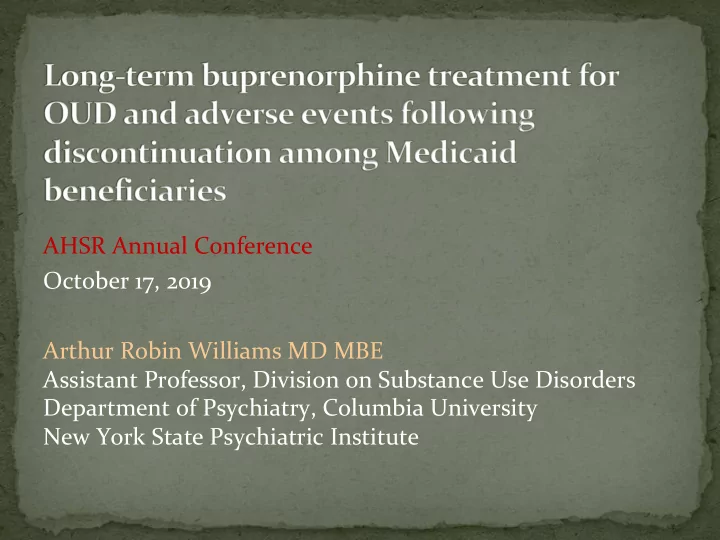

AHSR Annual Conference October 17, 2019 Arthur Robin Williams MD MBE Assistant Professor, Division on Substance Use Disorders Department of Psychiatry, Columbia University New York State Psychiatric Institute
� Nothing to declare
� NIDA K23 DA044342-01 (Williams, PI) “Improving the treatment cascade of MAT initiation and retention for opioid use disorder” � NIDA 1R01DA047347-01 (Crystal, PI) “Opioid Overdoses among Medicaid Beneficiaries: Predictors, Outcomes, and State Policy Effects” � NIDA T32 DA031099 for Hillary Samples (Hasin, PI) � AHRQ R18 HS03258, U19 HS021112, and R18HS02346 (Drs. Olfson and Crystal) � CTSA UL1TR003017 (Crystal, PI)
� Arthur Robin Williams MD MBE � Mark Olfson MD MPH Department of Psychiatry, Columbia University New York State Psychiatric Institute � Hillary Samples PhD Department of Epidemiology, Columbia University Mailman School of Public Health � Stephen Crystal PhD Institute for Health, Health Care Policy, and Aging Research, Rutgers University
� 2-5 million with OUD in US � MOUD Initiation and Retention are key stages of OUD Cascade of Care � Buprenorphine/MOUD treatment reduces risk of overdose and death upwards 60-80% � Most patients discontinue treatment in 3-6 months � NQF endorsed a 180-day continuous MOUD measure � Not empirically based � Longitudinal studies difficult to conduct
OUD Treatment Cascade: 90-90-90 Gaps Williams AR, Nunes EV, Olfson M (2017). To battle the opioid overdose epidemic, deploy the “Cascade of Care” model. Health Affairs blog , March 13, 2017.
� Among Medicaid beneficiaries who were successfully retained beyond six months minimum � Assess 4 adverse health outcomes � ED visits (all cause) � Inpatient hospitalizations (all cause) � Receipt of opioid prescriptions � Medically-treated overdose � Following buprenorphine discontinuation (6 mo)
� MarketScan multi-state Medicaid claims � An estimated 5-8 states, anonymous � Covering 12 million beneficiaries annually � Enrollment information, insurance plan type � Demographic characteristics (age, sex, race) � Diagnostic codes � Billing codes across all services paid by Medicaid � Inpatient, outpatient, and emergency services � Prescription drugs/pharmacy billed to Medicaid
� Retrospective longitudinal cohort analysis � Continuously enrolled through 6 months following buprenorphine discontinuation � Calendar years: 2013, 2014, 2015, 2016, 2017 � Adults 18-64 years � Received buprenorphine continuously for ≥180 days � Cohorts retained for 6-9 months (ref.), 9-12 months, 12-15 months, and 15-18 months
� Adverse events were common across all cohorts � Almost half of patients (42.1-49.9%) seen in the emergency department at least once � Compared to those retained for 6-9 months, patients retained on buprenorphine for 15-18 months had lower odds of: � Emergency department visits, OR 0.75*** (0.65-0.86) � Inpatient hospitalizations, OR 0.79* (0.64-0.99) � Filling opioid prescriptions, OR 0.67*** (0.56-0.80) � No difference in medically treated overdose (~5%)
� Residual confounding, unmeasured variables � Not possible to ascertain indicators of addiction severity or response to treatment from claims data � However, covariates associated with addiction severity were included in all analyses (e.g. comorbid substance use disorder, mental illness) � Sample likely represents relatively stable patients � A minority of Medicaid patients reach 6 months � Likely differ from early drop-outs
� Lack of data regarding vital status � Unable to distinguish fatal from non-fatal overdose � Given that overdoses occurred at similar rates across cohorts, it is unlikely that fatal overdoses were differentially distributed across the study cohorts � Beneficiaries who experienced fatal overdoses in the field would have lost Medicaid eligibility and would therefore have been ineligible for analysis in this study � Excluded Medicare/duals � May not generalize to other publicly or commercially insured, or uninsured, populations
Recommend
More recommend